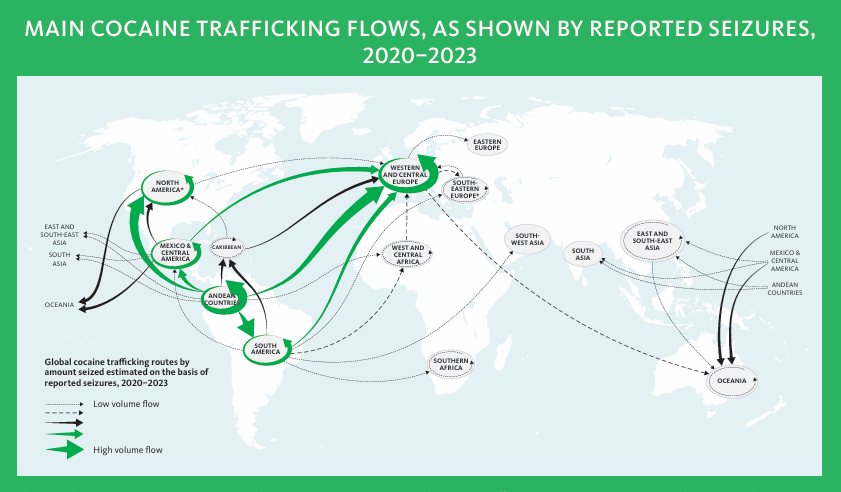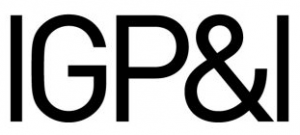Rising cocaine production and evolving trafficking routes are creating serious risks for commercial vessels, highlighting the need for vigilance, preventive measures, and fair treatment of crews.

Cocaine trafficking is on the increase – hot spots and preventive measures
Published 05 November 2025
In its latest report, the United Nations Office on Drugs and Crime (UNODC) states that most indicators – those for production, seizures and use – point to 2023 being a record-breaking year for the global cocaine market. Estimated at 3,708 tons, production of cocaine increased by about a third more than the previous year. This is primarily a reflection of the increase in the size of the area under illicit coca bush cultivation in Colombia. The area under cultivation in Bolivia stabilized in 2023 and declined slightly in Peru, according to UNODC
The report also highlights that the main cocaine trafficking flows continue to be from the Andean countries to North America and from the Andean countries to Europe, either directly or, to a lesser extent by way of West and Central Africa. Based on rising seizures and increasing cocaine use as indicated by wastewater analysis, UNODC reports that cocaine flows to Europe have increased dramatically compared to North America. Furthermore, the cocaine seizure data indicate a recent expansion of cocaine trafficking to Asia.
In contrast to cocaine, Afghan opium and heroin production and transport remain at the lowest levels since 2001, according to UNODC. Production in Myanmar fell by 8% - a bit of good news in an otherwise gloomy outlook. That said the UNODC has raised the concern about the potential replacement of heroin with synthetic opioids like fentanyl the use of which has been spreading rapidly across regions worldwide.
In Gard’s experience cocaine trafficking using commercial vessels as unwitting “drug mules” is increasing with the associated perils to crew and ship when drugs are found. In this article, we therefore primarily focus on the cocaine seizures.

Source UNODC World Drug Report 2025 – Key Findings
Concealment of drugs on commercial ships
Packages of narcotics can be concealed within cargo inside of a container or within the structure of the container itself, hidden in the walls or below the floor. Reefer containers provide opportunities for hiding packages in the refrigeration units. Packages may be placed by rouge employees working for shipping companies or terminals and there have been reports of drug traffickers disguised as port officials and stevedores marking containers as checked with replicated official seals. Once a container is sealed and delivered for loading, the crew has no opportunity to inspect the interior.
Drug traffickers also conceal packages within bulk cargoes. In 2019, Malaysian authorities seized twelve tons of cocaine concealed in a bulk shipment of coal. One of Gard’s Members unwittingly loaded bulk sugar that contained packets of cocaine that were found when they became entangled within the shore hopper at discharge.
Smugglers also use the ship’s external structure by attaching a box to the hull or drugs can be concealed by a diver in the rudder trunk in water-tight bags. Seafarers are also vulnerable to coercion and manipulation by sophisticated drug cartels to hide drugs in void spaces within the ship.
Hot spots and preventive measures
High risk areas for cocaine smuggling include Colombia, Ecuador, Peru, Mexico, Brazil and Venezuela. Patterns may change due to increased pressure by law enforcement both by authorities in countries of production and countries where the drugs are found. Use of the military against suspected drug smuggling boats by the current U.S. administration may also push more activity toward commercial vessels.
Under the ISPS Code, it is the responsibility of port authorities, shipping companies and seafarers to ensure safety and security at port. This includes preventing unauthorised personnel from accessing port facilities or boarding vessels, implementing proper security plans, and ensuring all personnel are trained, aware and know how to detect and mitigate potential security threats. However, we advise vessel operators and their masters to exercise particular caution when calling at ports susceptible to drug smuggling, and to:
Obtain a port update from the vessel’s local agent and carry out a voyage specific threat and risk assessment prior to calling the port.
Review the Vessel’s Security Plan, adopt relevant preventive measures, and brief the crew accordingly. It is important that the master and crew take all possible precautions to limit access to the vessel and monitor the surrounding area adjacent to the vessel while in port, such as:
Enforcing single entry points onto the vessel and limit access to the vessel to essential personnel only.
Making sure all external persons record their appropriate details and paperwork before boarding and informing the Master or Chief Officer if there is doubt about an individual’s legitimate reasons to be onboard.
Registering all packages before allowing them to be brought on board.
Placing a permanent watchman in areas where stevedores or repair technicians are working onboard the ship.
Observing the vessel’s CCTV system and storing the feed for review.
Using the vessel’s lights to illuminate all accessible areas onboard and the surrounding waters.
Maintaining a proper lookout for any suspicious activity observed close to the vessel, for example, small boats or divers.
If crew members are allowed to go ashore, advise them to refuse to carry aboard any package requested of them by “newly made friends”.
Once cargo operations are completed, perform a full search of the vessel. If there are any suspicions that drugs may have been placed onboard, request a comprehensive vessel inspection, including inspection of the vessel’s hull below the waterline, before departure.
Contact one of Gard’s local correspondents for appointment of guards, sniffer dogs, and underwater hull inspections. Making the appointment through the correspondent ensures that the contracting companies are approved and certified for this type of service.
Report any attempt, or suspected attempt, of drug smuggling to the local authorities, vessel agent, and P&I correspondent. If drugs are found onboard, do not touch the drugs. Take a photo or video of the area of the vessel where the drugs were found and seal it off to prevent any unauthorised access.
Familiarize themselves with, and ensure their onboard procedures refer to, the “
”
What if drugs are found on board or attached to the hull?
In Gard’s experience, there are only a small number of cases where drugs are discovered on board or attached to a vessel. The consequences can, however, be very severe for both the owners and the crew. The investigations by the authorities will take time. The vessel will almost certainly be delayed. The crew will be questioned closely and may be detained ashore, before being released – provided the authorities are satisfied none of them was involved in the attempt to smuggle drugs. If suspected of complicity, crew members may be detained ashore in prison and may in due course be charged with such an offence. Depending on the jurisdiction and the facts of the case, a substantial fine may be imposed and the vessel may be threatened with confiscation.
Members and clients are recommended to co-operate fully with any authority carrying out such an investigation irrespective of the jurisdiction and regardless of it being demanding and time-consuming for those involved. Gard will normally assist by facilitating the appointment of correspondents, lawyers and, if deemed necessary, experts.
Fair treatment of seafarers in the event of an investigation
Unfortunately, seafarers can be treated poorly and unfairly during drug seizures and investigations, even when they played no part in the crime. As noted by the ITF:
“When a vessel is involved in smuggling, transportation of illegal cargo or other criminal activities, it is common practice to detain the whole crew, sometimes for a long period of time, without there being justification for this. But if there is a media storm then the ship’s crew can be the easiest target when public authorities seek to demonstrate they are taking action. Seafarers have a right to undertake their work without fear of being treated unfairly, or, even worse, placed in detention without recourse to fair justice and representation.”
The criminal laws applicable to seafarers alleged to have assisted in drug smuggling depend upon the jurisdiction where the vessel is located when drugs are discovered and seized. While most if not all jurisdictions include some form of due process rights for those accused of crimes, the transitory nature of vessel port calls can result in prolonged detention of seafarers, particularly the vessel’s Master despite no indication of participation in the crime. In Gard’s recent experience, detention of crew pending investigation ranged from five weeks in one jurisdiction to a year and a half in another.
To address the international concern with the rights of seafarers, the ILO/IMO Guidelines on fair treatment of seafarers detained in connection with alleged crimes were developed by the Joint ILO–IMO Tripartite Working Group and adopted in November 2024. The Guidelines are not mandatory but intended as a reference for national policies, laws, and practices.
“The Guidelines are intended to reinforce existing human rights, including the principle of presumption of innocence until proven guilty by a proper legal process; and ensure that no seafarer is subject to arbitrary detention; no seafarer is deprived of their liberty, except on such grounds and in accordance with such procedures as established by law; and that no seafarer, in particular the Master, is detained on suspicion of committing an alleged crime solely because of their status on board the ship.”
The guidelines build upon the ILO/IMO Guidelines on the Fair Treatment of seafarers in the event of a maritime accident published in 2006. The guidelines are also based on principles from the Maritime Labour Convention (MLC, 2006) and other international human rights instruments. The guidelines speak to the responsibilities of each stakeholder:
Port or Coastal States
Ensure due process, humane treatment, and access to legal and consular support.
Avoid unnecessary detention and consider non-custodial alternatives.
“ensure that seafarers, once interviewed or otherwise not required for a port or coastal State investigation, are permitted, without undue delay, to be re-embarked or repatriated at no cost to the seafarer concerned, in accordance with the provisions of the MLC, 2006; 9 consider non-custodial alternatives to pretrial detention (including detention as witnesses);”
Facilitate repatriation and visitation by family.
Flag States
Support detained seafarers through communication, legal assistance, and subsistence provisions.
Ensure shipowners meet contractual obligations.
Cooperate with other states to secure fair treatment and prompt release.
State of Nationality
Monitor treatment and well-being of detained nationals.
Facilitate repatriation and consular access.
Prevent discrimination or retaliation against seafarers.
Shipowners
Uphold human rights and contractual obligations.
Provide support during investigations, including wages, accommodation, and medical care.
“immediately, upon any detention of a seafarer, establish whether the seafarer has any specific needs, for example, in relation to their gender, their religious beliefs and any medical requirements, and, with the consent of the seafarer, communicate these specific needs to all substantially interested States with the aim of ensuring that these needs are met;”
Inform families and cooperate with authorities. Involvement of the Embassy for the seafarers' home country is also recommended where detention is prolonged.
Seafarers
Encouraged to know their rights and attend pre-departure orientations.
Entitled to fair treatment, legal support, and repatriation without cost.
Prevention is better than cure
Those members that have experienced a drug seizure will confirm that the fall out is extremely stress-full for all involved, from the seafarers to the shore personnel. While Gard will assist the members, the criminal fines are not covered as a matter of right, and the inevitable detention of the vessel will likely result in the owner’s breach of contractual obligations resulting in uninsured financial losses. In addition to financial loss, intangible damage may be done to the member’s reputation and seafarers may experience trauma due to the investigation and detention. Clearly, exercising precautions in high-risk areas pays off.
Resources:
International Chamber of Shipping information on Central and South American ports (ICS)
Revised guidelines for the prevention and suppression of the smuggling of drugs, psychotropic substances and precursor chemicals on ships engaged in international maritime traffic (IMO Resolution FAL.9(34) adopted on 30 March 2007)




